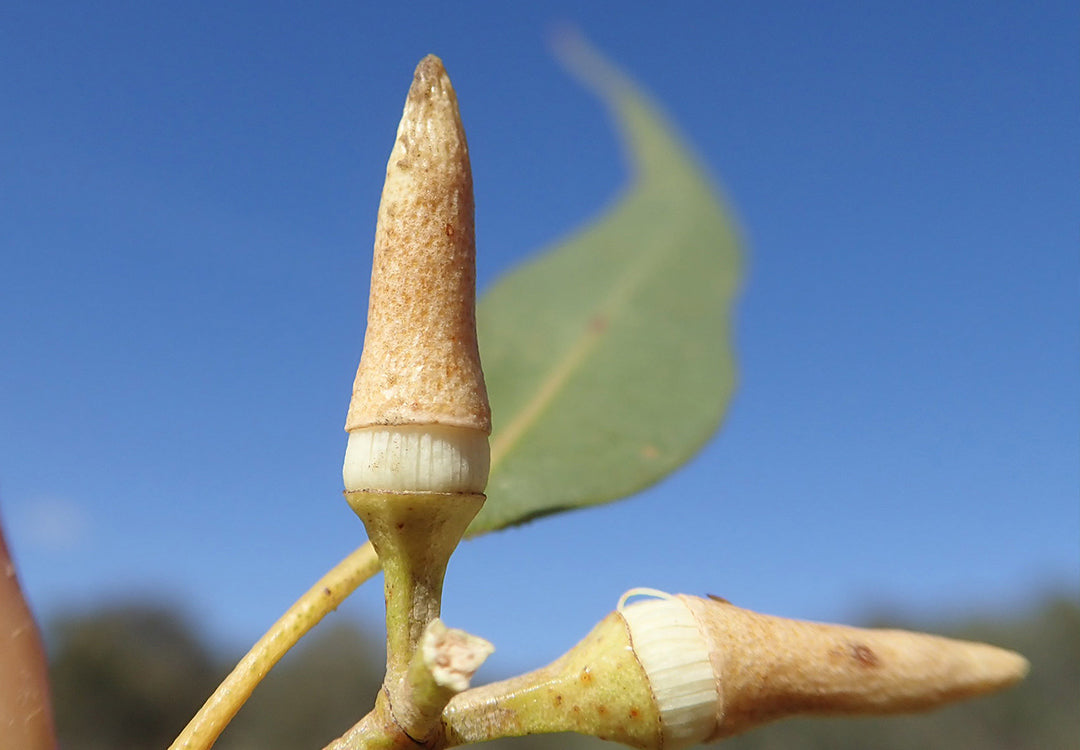
Eucalypts are plants within 7 genera of the myrtle family Myrtaceae that share a number of characteristics, and are native to Australia and a select few other nearby countries and islands. They produce the medicinal eucalyptus oil which is anti biotic and anti viral medicine for external use, as well as being a nasal decongestant.
Nothing says “Australia” quite like a good, old gum tree, does it? The only thing more Aussie would be if there was a koala eating its leaves.
Description
Mostly trees with a few woody shrubs in the mix, the family can be identified by their bark, flowers, gum nuts and scented leaves.
There may be a single leading branch or the tree may be multi-stemmed. Mallees are small eucalypts that have a tuberous base.

A ribbon-barked Eucalyptus sp. with a main trunk. Image source

Red mallee Eucalyptus socialis showing a normal mallee habit. Image source
Each year most plants will shed an outer layer of bark and put on a new layer, sometimes resulting in spectacular colouring as in rainbow eucalyptus. The shedding bark helps get rid of pests growing on their surface and sometimes has the ability to photosynthesise. Some eucalypts retain their bark such as iron gums.
The Eucalypteae tribe includes the Allosyncarpia, Angophora, Arillastrum, Corymbia, Eucalyptopsis, Eucalyptus and Stockwellia genera which are all referred to as eucalypts or gums.
Flower buds are covered by a cap that pops off when they bloom, revealing their distinctive fuzzy stamina. If the plant isn’t currently flowering or fruiting, there are usually some gum nuts on the ground beneath the foliage.

Flower caps popping off as the buds open on Eucalyptus tereticornis. Image source

The many stamens and single pistil of a Eucalyptus sp. flower. Image source

Gumnuts and tiny seeds of Eucalyptus obstans. Image source
Flowers, Fruits & Leaves
calyptra: 5 fused sepals and 5 fused petals form an outer and inner “calypra” or capping.
Male: Numerous stamina are prominent, often brightly coloured and give the flower a fuzzy appearance.
Female: Usually a single pistil is present.
Fruit & Seeds: Called a gum nut, the woody fruit capsule contains numerous tiny seeds. Often fire is required for germination.
Leaves: Leaves are evergreen with a waxy coating, coming in a variety of shapes sizes including round, falcate and ribbon-like.
Bark Types
Eucalyptus bark is one of the major methods of identification and can be described as rough or smooth. Beyond this simple description, there are a few more specific terms that can help us differentiate types. The bark types may or may not reflect how closely plants are related within the genus.
Ribbon barks have smooth, long ribbons that peel off the bark. There are often messes of ribbons that get caught in branches or may be curled on the ground, still attached to the base of the tree or mallee.

Sydney blue gum Eucalyptus saligna is an example of a ribbon gum. Image source
Scribbly bark types are smooth and similar to ribbon barks, but with distinctive scribbly markings created by a tiny “scribbly moth” larvae that burrows beneath the old bark which are exposed when it sheds.

Scribbly bark on a Eucalyptus haemastoma. Image source
Stringy barks can be recognised by their rough, thick, fibrous bark that early colonists used for roofing on their huts. This group is an artificial grouping based on their appearance, instead of a natural or scientific taxonomical classification.

Stringy bark on a Eucalyptus laevopinea. Image source
Iron barks are rough and do not shed their bark as is the norm within the genus; instead they accumulate it as a protective layer that can protect epicormic buds from fire, which helps them recover. The bark is dark grey to black in colour and furrowed, resembling slag, the biproduct of smelting iron that lends their name. These plants have a deep red sap that may be crystalised on the outside of the bark.

Iron bark on a Eucalyptus cebra. Image source
Noteworthy Types
E. regnans is the tallest flowering tree in the world, though there are connifer varieties that tower over even this monster. The tallest specimen, named Centurion, stands at just over 100m in Tasmania.

Old Centurion himself, Eucalyptus Regnans. Image source
Rainbow eucalypts E. deglupta are a stunning specimen of a plant, and quite possibly may have a good shot at having the most beautiful bark in the world. Purples, greens, yellows, oranges and reds are exposed as ribbons or old bark peel off to reveal the differing levels of bark maturity.

The bark of Eucalyptus deglupta is completely unreal. Image source
The snow gum E. pauciflora and the Tasmanian snow gum E. coccifera are another couple of examples of spectacularly colourful smooth gums.

Tasmanian snow gum Eucalyptus coccifera with another stunning smooth bark texture. Image source
Conclusion
This is one of the most widespread genera in Australia and there are varieties to suit almost any climate and soil; nothing beats a classic Aussie eucalypt.
